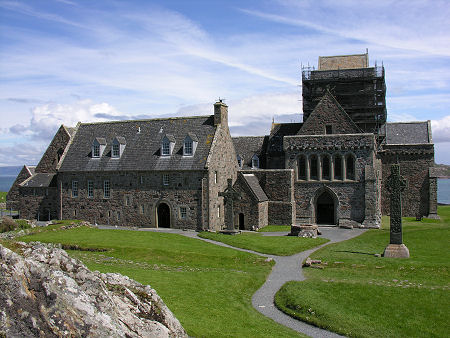 Iona Abbey Today |
St Columba lived from 7 December 521 to 9 June 597. The name he is known by today is the Latin version of his given name Colum, though he came to be known as Colum-cille, or "dove of the church" by most people in his own day. The wider picture in Scotland at the time is set out in our Historical Timeline.
Columba was born at Garten, County Donegal, Ireland. He was a member of the Clan O'Donnell, and was of royal descent. His father was Fedhlimdh and his mother Eithne. On his father's side he was great-great-grandson of Niall of the Nine Hostages, an Irish king of the fifth century. Much of what we know about him comes from a Life of Columba written by his successor Abbot Adomnán of Iona who lived a century later.
Columba was educated at the monastic school of Moville under St Finnian, who had himself studied at St Ninian's "Magnum Monasterium" on the shores of Galloway. In 560 a dispute arose over a copy Columba had made of St. Finnian's book of psalms. The result was Columba's instigation of a rebellion by the Clan Neill against King Diarmait of Ireland. This culminated in the Battle of Cooldrevny in 561, at which three thousand men were killed.
Following the battle, Columba's confessor, St Molaise, set him the penance of leaving Ireland and preaching the Gospel in order to convert as many to Christianity as had been killed at Cooldrevny: and never again to look upon his native land.
In 563 Columba and 12 companions left Ireland, arriving first at what is today Southend, on the southern tip of Kintyre. This, though, was still within sight of Ireland, so they travelled further north, landing on Iona on 12 May 563. The island was granted to Columba for the establishment of a monastery by King Conall of a distant relative. His contemporary, St Moluag, had established a church on the Isle of Lismore the previous year.
At this point Columba was 42 years old. He started his evangelising amongst the Scots of Dalriada, but then turned to the more testing task of converting the northern Picts of Caledonia. The corner was turned when, together with St Comgall and St Kenneth, Columba called on Pictish King Brude at his fortress overlooking what is now Inverness. Brude refused to allow the missionaries into the fortress, but - it is said - at the sign of the cross being made by Columba the barred gates of the fortress simply opened. The story goes on to record that the King, overawed by this miracle, was converted on the spot, with the rest of the Picts not long after him.
Another story relates how on one of his journeys, St Columba encountered several Picts who were burying the body of a man who had been killed by an aquatic monster which lived in the River Nesa: a story that has often since been intepreted as the first written reference to the Loch Ness Monster. It goes on to say that Columba then saved another man from the monster by ordering the beast to retreat, which it did.
St Columba died in the monastery he has build on Iona, in 597. The island became a place of pilgrimage, and has remained so ever since despite St Columba's own remains being removed in 849. They were apparently divided between the Scots and the Irish, with half being sent by King Kenneth I for safekeeping to Dunkeld. The other half was taken to the Church of Downpatrick.
St Columba's feast day is celebrated on June 9. Despite his obvious candidacy for the role, St Columba was supplanted by St Andrew as the patron saint of Scotland.

